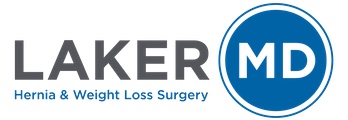Hernia 101
What is a Hernia?
A hernia refers to tissue or an organ from one body cavity moving into another space where it should not normally be. In the majority of cases hernias are related to defects of the abdominal wall or diaphragm. The given medical “name” is based off of the location and nature of the hernia. A hernia is not something that is removed. Hernias are repaired. A punctured bicycle tire can be repaired in a number of ways. The tire puncture could be glued primarily, a patch placed over the opening or perhaps below the opening. Regardless of technique, the problem area remains, it is not removed.
Dr. Scott Laker is now offering special pricing for those wishing to self-pay their hernia operations. See our Affordable Hernia Surgery in Michigan page for more details.
The medical term hernia is derived from the Greek word “hernios” that translates to “bud or offshoot”. Hernias are typically identified as a bud or protuberance in the groin, navel and various other areas of the abdominal wall.
A well-worn pair of blue jeans will occasionally fray at the knee as a result of repetitive stress from movement and bending. The fabric initially stretches to accommodate the strain but continued use eventually fractures the threads and a hole develops. In many ways this is similar to what hernias are and how they develop. If your knee begins to protrude through the opening your knee is herniating through a hernia in your jeans.
The jeans can be repaired in a number of ways. The hole can be sewn or patch placed over the opening or behind the opening. Regardless of technique, the problem area remains, it is not removed.
For some, this is fashionable, when it occurs to the abdominal wall it is not.
Hernias of the Groin
Hernias of the Abdominal Wall
Why are hernias a potential for problems?
For some, hernias are a source of chronic pain and discomfort. For others, the hernia may be felt to be disfiguring or unsightly. It is not uncommon for patients to tell me that they feel uncomfortable wearing certain clothes for fear that the hernia makes them appear pregnant or misshapen.
Hernias, in general, enlarge over time becoming more symptomatic. Symptoms generally correlate with the location of the hernia and what is protruding through the defect. Although relatively rare, intestinal blockage remains one of the most common indications for emergency hernia surgery. When an organ, typically bowel, has been trapped for a period of time there can be potential for a reduction in blood flow and subsequent gangrene and perforation. The end result being overwhelming, life threatening infection.
The majority of hernias don’t lead to a life threatening emergency. If you think you may have a hernia have your doctor evaluate.
How do I know if I have a hernia?
The most obvious but not always the most common way patients identify a hernia is appreciating a “bump or lump” in the area of concern. The mass may be identified while taking a shower, exercising or getting dressed. Pain or discomfort is the most common symptom first noted by patients who present to my office with concerns related to a hernia. Symptoms, in general, correlate with location of the hernia and what tissue/organ is bulging through the defect. For some, entrapment or pinching of intra-abdominal fat causes a generalized abdominal aching, sense of bloating, nausea or the feeling of the need to have a bowel movement. Others will describe a “burning” or “pulling” sensation when making certain movements.
If intestine becomes trapped within a hernia the person may experience bloating, nausea, vomiting or cramping abdominal pain. Severe pain, retching/vomiting, diarrhea or fever/chills may signify a more serious situation and emergency evaluation is recommended.
How are hernias diagnosed?
The majority of hernias are easily identified by a trained physician on physical examination. Inguinal hernias are much easier to diagnose in men than women because of anatomical differences between the male and female inguinal canal. Occasionally, radiologic evaluation is required to make the diagnosis.
Inguinal hernias in females can generally be detected with dynamic U/S and in rare situations MRI may be required. CT imaging may be useful for pre-operative planning.
